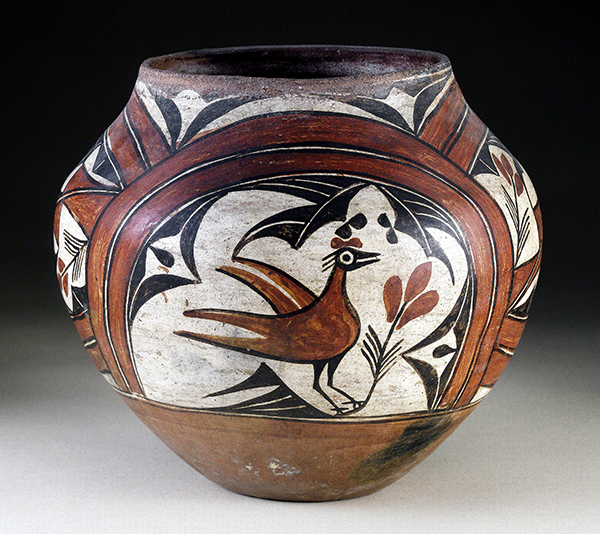Native American Heritage Month: Zia Pueblo
Today I present a work that reflects the abundance of rich indigenous cultures that populated the U.S. long before European settlement. The Anasazi of the western and southwestern U.S. were an amazing culture that was a forerunner of the Pueblo cultures that now populate the Southwest.
 |
| Zia Pueblo (Sandoval County, north of Albuquerque, New Mexico), Water Jar, late 1800s. Clays and pigment, 11 ¾" x 7 5/16" (29.9 x 18.5 cm). © 2022 Worcester Art Museum, Worcester, MA. (WAM-262) |
Pueblo cultures are particularly renowned for thin-walled wares. Before the clay is used, it must be sifted and winnowed to remove unwanted twigs, stones, and other debris. Then it is pulverized with a stone and temper is mixed into the crushed clay. Temper (sand, ground stone, or ground pieces of fired ceramic) strengthens and binds the clay to prevent cracking and shrinking during firing. A modest amount of water is also added to the mixture to make the clay malleable. This enables the potter to create the characteristically thin-walled vessels.
After the pots are formed, they are scraped smooth and painted surface designs are applied. Zia wares are typically black and red on a cream-colored body. The pigment is applied before firing, often with the traditional yucca brush that has been used for hundreds of years. In earlier times, pots were fired in open-air kilns fueled by dung. Since the 1970s, some Pueblo potters have used electric kilns. Pueblo pottery is fired at very high temperatures (about 1023°C/1873°F), which make the pot stronger. During firing, the pigments are bonded permanently to the clay.
The water jar above is a traditional olla shape. The pattern is a common motif of the desert parrot, which nibbles on a yucca plant. Pots such as this were used to collect water and were carried on the head. The thin walls of the vessel allow water to evaporate through the walls, keeping the water cool.
The First Nation cultures of the Southwest developed over thousands of years and flourished between 500 and 1100 CE. There were three major prehistoric cultural groups in the Southwest—the Anasazi in the Four Corners region (where the borders of Utah, Colorado, Arizona, and New Mexico meet); the Hohokam in southern Arizona; and the Mimbres Mogollon in the central and southeastern sections of Arizona and New Mexico. These early societies used both agriculture and hunting for food.
The Anasazi people built great multistoried, connected towns of fieldstone and adobe, called pueblos. The term pueblo was coined by the Spanish to describe what looked to them like towns. Most modern-day Pueblo cultures are descended from the ancient Anasazi. There are hundreds of distinct Pueblo cultural groups, among them the Zia culture.
The Anasazi built Zia Pueblo around the 1200s. Today, about 850 descendants of the Anasazi continue to inhabit the pueblo. When the Spanish came in the 1500s, it was thought to be the largest of the Anasazi pueblos in the Southwest.
Ceramics is the major art form that has survived from the early Pueblo cultures. The patterns on ceramic objects commonly symbolize elements of nature that are vital to the survival of an agriculturally based society. Zia pottery, like all traditional pottery of the Southwest, is coil-built earthenware. As with many of the Pueblo cultures, most Zia pottery is formed by women with the surface designs often painted by men.
Correlations to Davis Programs: The Visual Experience 4E: 10.10; Experience Art: 2.3; A Global Pursuit 2E: 2.5; A Community Connection 2E: 1.4, 2.6; Explorations in Art 2E Grade 5: 5.9; Explorations in Art 2E Grade 4: 4.9; Explorations in Art 2E Grade 3: 6.7; Discovering Art History 4E: 4.10


Comments